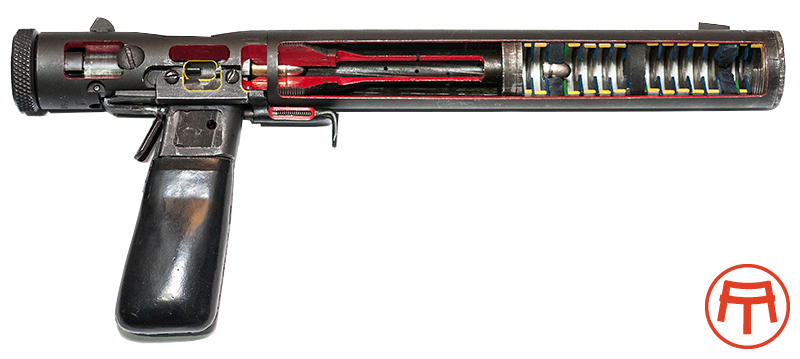|
INTRODUCTION
The aim of this site is an attempt to uncover the history of the Welrod pistol, as well as the distribution and use of it, during the German occupation of Denmark. There are only a handful of reports and descriptions regarding the use of this pistol, which most likely accounts for the fact that the Welrod to this day remains relatively unknown.

Welrod MkIIA © Anders Thygesen. Cross sectioned, note the projectile in the first rubber baffle.
Alas, in my view, the Welrod pistol gained an unjust reputation for being unreliable and lacking sufficient "power". But keeping in mind the purpose for which it was built, and accepting the inherent limitations of such a design, it entirely fulfilled its role. The Welrod pistol in my opinion is an exceptional piece of weapons-technology.
The Welrod was produced in three basic versions: the Mk.II and Mk.IIA, chambered the .32 ACP round , and the Mk.I, chambered for the 9mm Parabellum . I find the Mk.II and Mk.IIA, .32 ACP, to be the more interesting of the two, as it was the only version to be delivered to the Danish Resistance. However, in the interest of thoroughness, I have chosen to also bring a full description of the Mk.I.
The original history behind the development and production of the Welrod pistol has proven hard to trace. Most of the information regarding the origins of the pistol has either disappeared, or has been destroyed. Although the identity of the manufacturer is still not officially confirmed, copies of the original drawings carrying the B.S.A. stamp, has recently surfaced proving that B.S.A. was in fact the main contractor on the project.
Besides just recently a friend of mine Brian Moyse, told me about an early reference to the Welrod pistol that stemmed all the way back to July 1946. It is in the book “The Other Battle” telling the history of B.S.A. written by Donovan M. Ward. How that slipped through the censor in 1945 is most puzzling, but it is reasonable to believe that B.S.A. got away with it because at that time the Ministry staff were more preoccupied with other matters.
On page 147 in Chapter XXIII, Rush Jobs - And Others:
"Special weapons for Resistance Forces in Europe, R.A.F. bomber turrets, shell cases, gun carriages, field gun trundlers-these and a host of other munitions were manufactured by B.S.A. during the war in addition to the armaments already described.
One of the most deadly weapons used by members of the French Resistance Movement against the occupying German forces in the months before D-day was manufactured at Small Heath. This was the Welrod Silent Pistol. Although from 1942 onwards the French were receiving regular supplies of normal military arms and ammunition dropped at night by parachute from R.A.F. planes, these were only of use in regular warfare. There was an obvious need for a weapon with which the war of nerves could be carried into the dance halls and cafes frequented by German officers and men; and it had to be a weapon which would give the user a chance to escape after an "execution".
Late in 1943 the War Office asked B.S.A. to manufacture a pistol, which had been specially designed by an army major. In the matter of silence it was the most perfect gun of its kind ever evolved, for when the tip of the muzzle was pressed into a sandbag and a shot fired, there was only the faintest noise, which would pass unnoticed in the normal chatter and clatter of a cafe.
To enable it to be manufactured quickly on the large scale required, the company's experts simplified the design. Within six weeks the first batch was on its way to France, and with them a new reign of terror was instituted against the men who were shooting hostages by the score and wiping out whole villages just as they had earlier exterminated Lidice in Czechoslovakia."
In addition to the commonly available literature on the subject, I have obtained information part through correspondence with museums and different authorities, and part with the assistance of fellow-minded people throughout the world with a shared interest in historical weaponry. In the end, the accumulated material has been pieced together to relatively form a whole.
|

